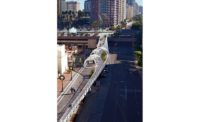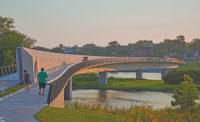
Acomputational-fluid-dynamics software update helps architects to avoid building designs that are too blustery for the comfort of pedestrians walking through urban areas.
"The main benefit of UrbaWind is the graphical display of results," says Shannon Testart, CAD technician for microclimate at Novus Environmental Inc., Ontario, Canada, who uses the software. "The graphics of wind comfort are an efficient way to display results and are easily understood by our clients."
UrbaWind 2.2 by Meteodyn, Nantes, France, accounts for the angles of buildings, trees and other cityscape features to calculate pedestrian-level wind comfort in complex urban environments, says Stephane Sanquer, product manager at Meteodyn.
A new element in version 2.2 is its ability to connect to the U.S. Dept. of Energy's EnergyPlus database and read so-called energy + weather, or EPW, files. "The files introduce climatology into CFD building design," says Sanquer.
Testart notes the importance of selecting and setting up the meteorological data to ensure accurate wind predictions. However, the downside is how long these computations take, she adds. "Even with multiple processors, analysis runs can take several days to complete," says Testart.
Though similar CFD tools abound, such as advanced physics analysis software from ANSYS Inc. or free programs from Envi-Met, Sanquer says UrbaWind is cheaper and easier to use than the former and more accurate than the latter.
"DesignBuilder and [Python's] Virtual Environment claim to be able to compute the flow in complex urban areas, but the reality is very different," says Sanquer. Since these programs were developed for indoor thermal studies, it is very difficult to apply them to an urban area, he adds.
"Unfortunately, coefficients are given in software with databases for only simple and detached buildings," says Sanquer. "For others configurations—namely, all the configurations included in complex buildings in urban areas—these values are wrong."
Testart says her company uses several approaches to conduct wind studies, from spreadsheet- and knowledge-based expert systems to scale-model wind-tunnel studies. UrbaWind is best used as a powerful tool for screening-level analyses at early stages of project design, she says.





